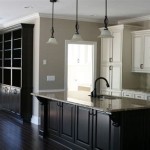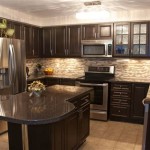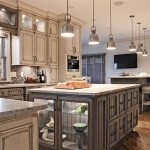How Much Do Kitchen Renovations Cost?
Kitchen renovations represent a significant investment for homeowners, enhancing both the functionality and aesthetic appeal of a central living space. Determining the precise cost of a kitchen renovation is a complex and multifaceted process, influenced by a wide array of factors. Understanding these factors is crucial for homeowners seeking to establish a realistic budget and avoid unexpected financial burdens. This article explores the various cost components associated with kitchen renovations, providing a comprehensive overview of the financial considerations involved.
The cost of a kitchen renovation can vary dramatically, ranging from minor cosmetic upgrades to complete overhauls. Minor renovations, such as painting cabinets, replacing hardware, or installing a new backsplash, may cost a few thousand dollars. More substantial renovations, involving significant structural changes, custom cabinetry, and high-end appliances, can easily exceed tens of thousands of dollars. The national average for a kitchen renovation falls somewhere in between, but it is essential to recognize that this figure represents a broad generalization and may not accurately reflect the specific circumstances of each project.
Accurately assessing the scope of the renovation is the first step in determining the potential cost. This involves defining the specific changes to be made, including whether the existing layout will be maintained or altered, the types of materials to be used, and the extent of any necessary plumbing or electrical work. A clear and detailed plan is essential for obtaining accurate estimates from contractors and suppliers.
Key Cost Factors in Kitchen Renovations
Several key factors exert a substantial influence on the overall cost of a kitchen renovation. Understanding these factors enables homeowners to make informed decisions about their budget and prioritize specific aspects of the project based on their individual needs and financial constraints.
1. Scope of the Renovation: The extent of the work to be performed is a primary driver of cost. A simple refacing of existing cabinets will be significantly less expensive than a complete cabinet replacement. Similarly, maintaining the existing kitchen layout will generally be less costly than reconfiguring the space, which may involve moving plumbing or electrical lines. Projects that involve structural changes, such as removing walls or expanding the kitchen footprint, will invariably incur higher costs due to the increased labor and materials required.
The scope also encompasses the level of customization desired. Stock cabinetry and pre-fabricated countertops offer cost-effective solutions, while custom-designed cabinets and countertops made from exotic materials will command a premium price. The selection of appliances also plays a crucial role. Standard appliances represent a more budget-friendly option, while professional-grade or smart appliances can significantly increase the overall cost.
2. Materials and Finishes: The choice of materials and finishes impacts both the aesthetic appeal and the cost of a kitchen renovation. Cabinetry, countertops, flooring, backsplash, and hardware all contribute to the overall expense, and the selection of these elements can greatly influence the final budget.
Cabinetry represents a significant portion of the kitchen renovation budget. Stock cabinets are typically the most affordable option, followed by semi-custom cabinets, which offer a greater degree of customization. Custom cabinets, designed and built to specific dimensions and specifications, are the most expensive. The material used for the cabinets, such as solid wood, plywood, or MDF (medium-density fiberboard), also affects the cost. Solid wood is generally the most durable and aesthetically pleasing but also the most expensive.
Countertop materials vary widely in price. Laminate countertops are the most affordable, followed by tile and solid surface materials. Granite and quartz countertops offer greater durability and aesthetic appeal but come at a higher cost. Marble and other natural stone countertops are considered premium options and represent the highest end of the price spectrum.
Flooring options also contribute significantly to the overall cost. Vinyl flooring is a budget-friendly option, while tile and engineered wood offer greater durability and aesthetic appeal. Hardwood flooring is a popular choice but can be more expensive than other alternatives. The cost of flooring also depends on the size of the kitchen and the complexity of the installation.
The choice of backsplash tile also influences the budget. Basic ceramic tile is the most affordable option, while glass tile, mosaic tile, and natural stone tile offer a more upscale look but come at a higher price. The complexity of the installation, such as intricate patterns or designs, can also increase the labor costs associated with the backsplash.
3. Labor Costs: Labor costs represent a significant portion of the total kitchen renovation budget. These costs encompass the services of various professionals, including general contractors, plumbers, electricians, carpenters, and tile installers. The expertise and experience of these professionals directly impact the quality and efficiency of the renovation.
General contractors typically manage the entire renovation process, coordinating the work of subcontractors and ensuring that the project stays on schedule and within budget. They typically charge a percentage of the total project cost, ranging from 10% to 20%. The specific percentage will depend on the complexity of the project and the contractor's overhead costs.
Plumbing and electrical work are essential components of many kitchen renovations, particularly those that involve relocating appliances or installing new fixtures. Licensed plumbers and electricians are required to perform these tasks, ensuring compliance with local building codes and safety regulations. The cost of plumbing and electrical work will depend on the extent of the work required and the complexity of the existing systems.
Carpenters are responsible for installing cabinets, trim, and other woodwork. Their expertise is crucial for ensuring that cabinets are properly aligned and securely fastened. Tile installers are responsible for installing flooring and backsplash tile, ensuring a smooth and professional finish. The cost of carpentry and tile installation will depend on the complexity of the work and the experience of the installer.
Strategies for Managing Kitchen Renovation Costs
While kitchen renovations can be expensive, there are several strategies that homeowners can employ to effectively manage costs and stay within budget. Careful planning, strategic material selection, and diligent contractor selection are essential for controlling expenses and maximizing the value of the investment.
1. Planning and Budgeting: A detailed plan and a realistic budget are the foundation of a successful kitchen renovation. Before embarking on the project, homeowners should carefully consider their needs and priorities, defining the specific changes they want to make and establishing a clear budget for the renovation. This process involves researching materials, obtaining estimates from contractors, and allocating funds for each aspect of the project. It’s important to include a contingency fund of at least 10% to cover unexpected expenses that may arise during the renovation.
Prioritizing specific aspects of the renovation is also crucial. Homeowners should identify the features that are most important to them and allocate the majority of their budget to those areas. For example, if high-quality cabinetry is a priority, they may choose to allocate a larger portion of their budget to cabinet materials and installation, while opting for more budget-friendly options for other elements, such as countertops or flooring.
2. Material Selection: The choice of materials can significantly impact the overall cost of the renovation. Homeowners should explore various material options and compare prices before making a decision. Opting for more affordable materials, such as laminate countertops or vinyl flooring, can help to reduce costs without sacrificing functionality. However, it’s important to consider the long-term value and durability of the materials, as cheaper options may require more frequent replacement. Exploring sales, discounts, and closeout items can also help to save money on materials.
3. Contractor Selection: Selecting the right contractor is crucial for ensuring a successful and cost-effective kitchen renovation. Homeowners should obtain multiple bids from different contractors, comparing their prices, experience, and references. It’s important to choose a contractor who is licensed, insured, and has a proven track record of completing similar projects. Verifying the contractor's references and reviewing their past work is essential. A detailed contract outlining the scope of work, payment schedule, and timeline should be established before the renovation begins.
4. DIY vs. Professional Installation: Homeowners with experience in home improvement may consider performing some of the renovation work themselves to save on labor costs. Tasks such as painting, demolition, and installing simple backsplashes can often be completed by DIY enthusiasts. However, it's important to recognize the limitations of one's own skills and expertise. Plumbing and electrical work should always be performed by licensed professionals to ensure compliance with building codes and safety regulations. Undertaking complex tasks without the necessary expertise can lead to costly mistakes and potential safety hazards.
5. Timing of the Renovation: The timing of the renovation can also impact the overall cost. Contractors may offer lower rates during slower seasons, such as the winter months. Scheduling the renovation during off-peak times can help to reduce labor costs. Additionally, planning the renovation during a time when appliance retailers are offering sales or promotions can help to save money on appliances.
Unexpected Costs and Contingency Planning
Kitchen renovations often involve unforeseen challenges and unexpected costs. It is crucial to anticipate potential issues and establish a contingency fund to address any surprises that may arise during the renovation process. Hidden plumbing or electrical problems, structural issues, and unforeseen material price increases can all contribute to unexpected expenses.
A contingency fund of at least 10% of the total project cost is generally recommended to cover unexpected expenses. This fund should be reserved for addressing unforeseen issues and should not be used for upgrades or additional features. Proactive communication with the contractor is essential for identifying and addressing potential problems early on, minimizing the impact on the budget.
Thorough inspections of the existing plumbing and electrical systems are crucial before commencing the renovation. This can help to identify potential problems and allow for proactive planning and budgeting. Consulting with a structural engineer may be necessary if the renovation involves structural changes, such as removing walls or expanding the kitchen footprint. This can help to identify any potential structural issues and ensure that the renovation is carried out safely and effectively.
Maintaining open communication with the contractor throughout the renovation process is crucial for addressing any unforeseen challenges and minimizing the impact on the budget. Regular meetings with the contractor can help to track progress, identify potential problems, and make necessary adjustments to the plan. Promptly addressing any concerns or issues that arise can prevent them from escalating into more costly problems later on.

A Detailed Look At Kitchen Remodeling Costs And Components

How Much Did Our Kitchen Renovation Cost Liz Pacini

The Cost Of A Kitchen Remodel Understanding Your Budget

Kitchen Remodeling Costs Phoenix

Ultimate Guide To Kitchen Remodel Cost Lily Ann Cabinets

How Much Do Kitchen Renovations Cost Kitchens Inc

What Is The Average Cost Of A Kitchen Remodel

How Much Does A Kitchen Remodel Cost Crystal

Kitchen Remodel Costs Cosmetic Remove Replace

Kitchen Remodel Fairfield County Costs And Expert Advice








